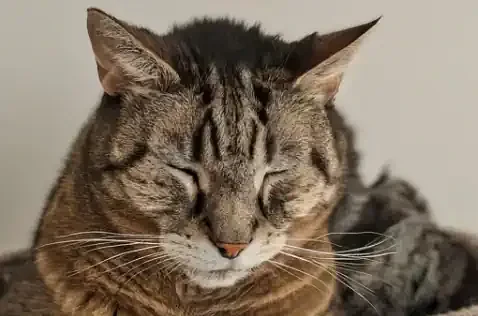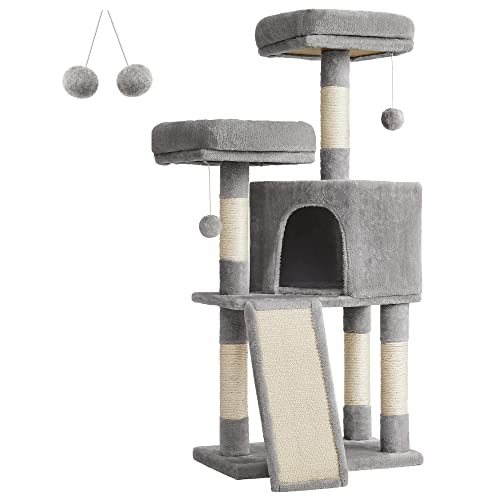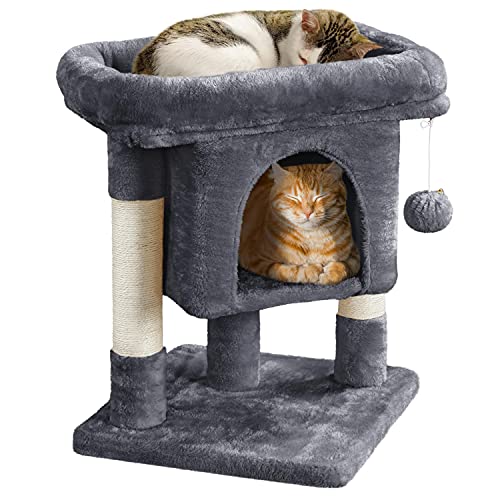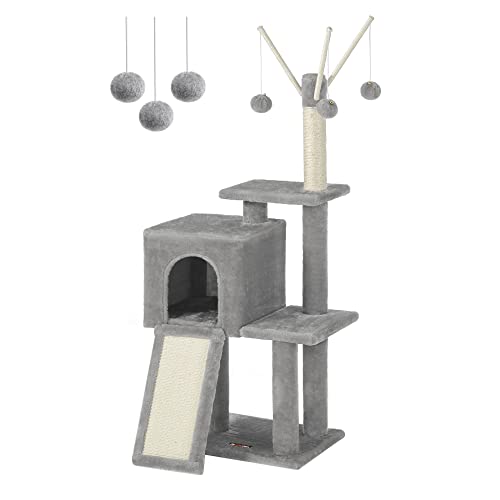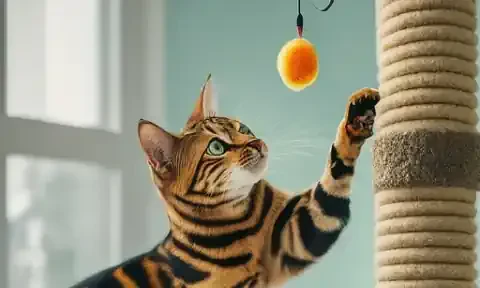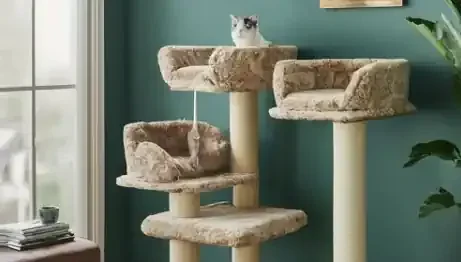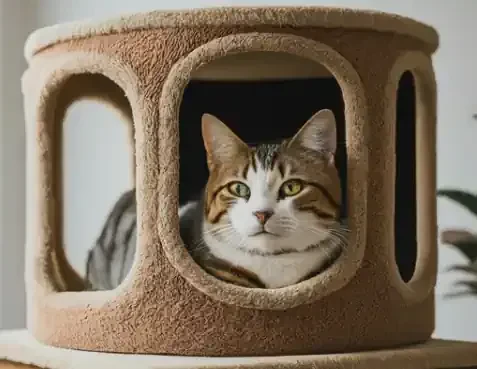Why Size Matters: The Importance of a Sturdy Cat Tree for Large Breeds
Large cat breeds, like the majestic Maine Coon or the playful Bengal, aren't your average house cat. Their size and weight demand a cat tree that's not only fun but also built to last. Investing in a sturdy and appropriately sized cat tree isn't just a luxury; it's a necessity for your feline friend's well-being and happiness.
Weight Capacity: When shopping for a cat tree for your large cat, the first and most crucial factor to consider is weight capacity. A cat tree should comfortably support your cat's full weight, with a little extra room for them to stretch and move around. Don't be fooled by a tree's height alone; look for manufacturers who explicitly state the weight limit their product can handle.
Stability is Key: A wobbly cat tree is a recipe for disaster. Imagine your large cat leaping onto a platform that tips and sways. Not only is this frightening for your pet, but it can also lead to injuries. Prioritize cat trees with wide bases, sturdy materials, and designs that distribute weight evenly. Look for features like anti-tip brackets or wall attachments for added security.
Material Matters: The materials used in a cat tree significantly impact its durability and longevity. Opt for solid wood construction over particle board or flimsy plastics. Solid wood can withstand the wear and tear of a large cat's claws and weight, ensuring your investment lasts for years. Additionally, choose scratching posts covered in sisal rope, a natural fiber that's both satisfying for your cat's scratching needs and resistant to fraying.
Design Considerations: Large cats need plenty of space to climb, play, and lounge. Look for cat trees with multiple levels, wide platforms, and spacious condos. Vertical space is especially important for these breeds, as they love to climb and survey their surroundings. Consider cat trees with varying levels of difficulty to challenge your cat's agility and keep them entertained.
Top Features to Look for in a Large Cat Tree
Choosing the right cat tree for your large feline friend involves more than just considering size and stability. It's about finding a structure that caters to their instincts, encourages play, and provides a comfortable haven. Here are some key features to look for when selecting a cat tree for your large cat:
Tall Scratching Posts: Scratching is a natural behavior for cats, essential for maintaining their claws and marking their territory. Large cats need tall scratching posts that allow them to fully extend their bodies while scratching. Look for posts made of durable materials like sisal rope, which can withstand vigorous scratching without fraying.
Spacious Platforms: Large cats need ample room to stretch out, perch, and survey their domain. Opt for cat trees with wide platforms that can accommodate their size comfortably. These platforms should be sturdy and well-secured to prevent tipping or wobbling when your cat jumps on or off. Consider platforms with different textures and materials, such as plush fabric or carpet remnants, to provide variety and appeal to your cat's senses.
Condo Hideaways: Cats are natural den animals, and large breeds are no exception. A spacious condo within the cat tree provides a safe and cozy retreat where your cat can relax, nap, or simply observe their surroundings in peace. Look for condos with multiple entry and exit points, allowing your cat to feel secure while still having options to escape if they choose.
Hanging Toys: Play is an essential part of a cat's life, and interactive toys can keep them entertained and mentally stimulated. Choose a cat tree with hanging toys, such as dangling balls or feathered mice, to encourage your cat to play and exercise. These toys can also help satisfy their hunting instincts and prevent boredom-related behaviors.
Additional Accessories: While the basic features mentioned above are essential, additional accessories can further enhance your cat's experience. Consider cat trees with hammocks for lounging, tunnels for exploration, or perches with built-in scratching pads. These extras can provide even more options for play, relaxation, and enrichment.
By prioritizing these features, you'll be well on your way to finding a cat tree that your large cat will love and use for years to come.
The Best Cat Tree Materials for Large Cats
Selecting the right materials for your large cat's tree is crucial for ensuring its longevity, safety, and appeal to your feline friend. Different materials offer varying levels of durability, comfort, and aesthetic appeal. Here's a breakdown of the best cat tree materials for large cats:
Solid Wood: A solid wood frame is the backbone of a durable and stable cat tree. It can withstand the weight and vigorous activity of large cats without wobbling or tipping. Choose hardwoods like oak, maple, or birch for their strength and resistance to warping. Avoid particle board or MDF, which can easily break down under pressure.
Sisal Rope: Sisal rope is the gold standard for scratching posts. This natural fiber is incredibly tough and can withstand even the most enthusiastic scratching sessions. Look for posts that are tightly wrapped with sisal rope to prevent unraveling. Sisal also provides a satisfying texture for cats to sink their claws into, encouraging them to scratch the post instead of your furniture.
Plush Fabric: While not as durable as sisal, plush fabric adds a touch of comfort and coziness to a cat tree. It's often used to cover platforms, perches, and condo interiors, providing a soft surface for your cat to nap or lounge. Choose high-quality plush fabrics that are resistant to pilling and fading. Consider removable and washable covers for easy cleaning.
Carpet Remnants: Carpet remnants offer a different texture for your cat to explore and can be used to cover scratching posts or platforms. Look for tightly woven carpets made from durable materials like nylon or olefin. Avoid looped carpets, as they can snag your cat's claws.
Natural Fibers: For eco-conscious cat owners, natural fibers like jute or hemp can be excellent alternatives to sisal rope. These fibers are biodegradable and renewable, making them a more sustainable option. They also provide a similar texture to sisal, satisfying your cat's scratching needs.
Choosing the right combination of materials for your large cat's tree will ensure that it not only looks great but also stands up to the test of time and provides your feline friend with endless hours of enjoyment.
Cat Tree Recommendations for Specific Large Breeds
Every large cat breed has its unique characteristics and preferences. Choosing a cat tree tailored to their specific needs can significantly enhance their enjoyment and ensure they get the most out of their climbing and scratching adventures. Here are some recommendations for popular large cat breeds:
Maine Coon Cat Trees: Known for their impressive size and love of heights, Maine Coons require extra-tall cat trees with sturdy platforms and robust scratching posts. Look for trees that reach at least 6 feet in height and have multiple levels with ample space for these gentle giants to stretch and lounge. A stable base and wide platforms are essential to prevent tipping.
Ragdoll Cat Trees: Ragdolls are known for their docile nature and love of cuddling. For these gentle giants, consider cat trees with soft and plush surfaces, cozy hammocks, and enclosed spaces where they can curl up and nap. While not as active as some other breeds, Ragdolls still enjoy climbing and scratching, so ensure the tree has sturdy posts and platforms.
Savannah Cat Trees: Savannah cats are known for their high energy levels and athleticism. These active felines need tall and challenging structures that allow them to climb, jump, and explore. Look for cat trees with multiple levels, varied scratching surfaces, and interactive toys like dangling balls or feathers to keep them engaged and entertained.
Norwegian Forest Cat Trees: These hardy cats are built for the outdoors and love to climb. Choose a cat tree with durable materials that can withstand their claws and active play. Look for trees with a natural aesthetic, incorporating elements like wood and sisal rope to mimic their natural habitat. Platforms with a view are also a plus, as Norwegian Forest Cats love to survey their surroundings.
Siberian Cat Trees: Siberians are known for their thick, luxurious fur and love of comfort. Opt for cat trees with large, plush platforms and cozy condos where they can relax and stay warm. Sisal-covered scratching posts are essential to help them maintain their claws, and interactive toys can encourage them to play and exercise.
By considering the unique needs of each large cat breed, you can find a cat tree that not only meets their physical requirements but also caters to their individual personalities and preferences.
Where to Place Your Large Cat Tree for Maximum Enjoyment
The placement of your large cat tree can significantly impact how much your feline friend enjoys it. Strategic placement can encourage play, relaxation, and a sense of security for your furry companion. Here are some tips for choosing the perfect spot for your large cat tree:
Near a Window: Cats are naturally curious creatures, and they love to observe the world outside. Placing the cat tree near a window provides them with a front-row seat to the daily drama of birds, squirrels, and other outdoor activities. The sunlight streaming through the window also creates a warm and inviting spot for your cat to bask in.
In a Social Area: If you want to encourage interaction and play, consider placing the cat tree in a social area of your home, such as the living room or family room. This allows your cat to be part of the action, observing and interacting with family members and guests. It also provides them with a vantage point to watch over their territory and feel more secure.
Away from Hazards: Safety should always be a top priority when placing your cat tree. Avoid areas near stairs, balconies, or other potential hazards where your cat could fall and injure themselves. Keep the tree away from hot surfaces, electrical cords, and other potential dangers.
In a Quiet Corner: While some cats enjoy being in the center of activity, others prefer a more secluded spot to retreat and relax. If your cat is more introverted, consider placing the tree in a quiet corner of your home, away from the hustle and bustle. This allows them to have a peaceful haven where they can unwind and recharge.
Near Other Cat Furniture: If you have multiple cat trees or other cat furniture, create a "cat zone" by placing them in proximity to each other. This can encourage exploration and play, as your cat can easily move between different structures and activities. It can also create a sense of security, as your cat will have a designated area where they feel safe and comfortable.
Remember, the best placement for your large cat tree will depend on your cat's individual personality and preferences. Experiment with different locations to see where your cat seems most content and engaged.
Maintaining Your Large Cat Tree for Longevity
A large cat tree is an investment in your feline companion's well-being, and like any investment, it requires proper maintenance to ensure its longevity and continued enjoyment for your furry friend. Regular upkeep not only keeps the cat tree looking its best but also ensures its safety and functionality for years to come.
Regular Cleaning: Cat trees can accumulate fur, dust, and debris over time, which can not only make them look unappealing but also harbor allergens and bacteria. Regular cleaning is essential to maintain a healthy and hygienic environment for your cat. Vacuum the surfaces, including platforms, condos, and scratching posts, to remove loose fur and dirt. Use a damp cloth and pet-safe cleaner to wipe down surfaces and remove stains. Be sure to let the tree dry completely before allowing your cat to use it again.
Tightening Screws and Bolts: Over time, the screws and bolts holding your cat tree together can loosen due to your cat's climbing and playing. Regularly check all the connections and tighten any loose screws or bolts to ensure the tree's stability and prevent accidents. Pay particular attention to areas that experience frequent use, such as scratching posts and platforms.
Replacing Worn-Out Parts: Scratching posts, platforms, and toys can wear out over time. Inspect these parts regularly and replace them as needed to maintain the cat tree's functionality and safety. Worn-out sisal rope on scratching posts can become frayed and pose a hazard to your cat's paws. Replace worn-out plush fabric or carpet remnants on platforms to prevent your cat from ingesting loose fibers.
Rotating Scratching Posts: To extend the lifespan of your cat tree's scratching posts, consider rotating them periodically. This will distribute wear and tear more evenly, preventing one section from becoming excessively worn out while others remain untouched. If your cat tree has multiple scratching posts, simply switch their positions every few months.
Inspecting for Damage: Regular inspections are crucial for identifying any potential hazards or damage to your cat tree. Look for loose or broken parts, frayed ropes, or unstable platforms. If you notice any damage, repair or replace the affected parts immediately to ensure your cat's safety. It's also a good idea to check for signs of pests, such as fleas or mites, and address them promptly if found.
By following these maintenance tips, you can extend the life of your large cat tree and ensure that it remains a safe and enjoyable haven for your feline companion. Regular upkeep not only protects your investment but also demonstrates your commitment to providing the best possible environment for your beloved cat.
Beyond The Basics: Additional Considerations For Large Cat Trees
While the core features and materials are essential, there are several additional factors to consider when choosing the perfect cat tree for your large feline friend. These considerations can further enhance your cat's experience and ensure their tree remains a beloved part of their environment for years to come.
Multi-Cat Households: If you have more than one cat, especially if they're all large breeds, you'll need to consider a larger cat tree or multiple trees to accommodate everyone. Look for trees with ample vertical space and multiple platforms, condos, and scratching posts to prevent overcrowding and territorial disputes. Consider spreading out multiple trees throughout your home to create different play and relaxation zones for each cat.
Senior Cats: As cats age, their mobility and agility may decline. Senior cats may have difficulty jumping or climbing onto high platforms. Opt for cat trees with easy-to-climb ramps or stairs, lower platforms, and spacious condos with wide openings. You may also want to consider placing the tree near other furniture, such as a couch or chair, to give your senior cat an extra boost.
Kittens: While your focus may be on your large cat, if you have kittens in the household, their needs should also be considered. Choose a cat tree with age-appropriate features, such as lower platforms, shorter scratching posts, and interactive toys designed for kittens. This will ensure that all your feline friends can enjoy the tree safely and comfortably.
Budget-Friendly Options: Cat trees can vary significantly in price, and finding one that fits your budget can be a challenge. While it's important to invest in a sturdy and durable tree for your large cat, there are affordable options available. Look for sales and discounts, consider buying a used tree in good condition, or explore DIY cat tree plans. Remember, the most expensive tree isn't always the best choice for your cat's individual needs and preferences.
DIY Cat Trees: If you're handy and enjoy DIY projects, building your own cat tree can be a rewarding and cost-effective option. You can customize the design, materials, and size to perfectly suit your cat's needs and your home's décor. There are numerous online resources and tutorials available with detailed instructions and plans for building cat trees. This option allows you to create a unique and personalized space for your furry friend while also saving money.
Summary
This comprehensive guide delves into the essential factors to consider when selecting a cat tree for large cat breeds. It emphasizes the importance of choosing a sturdy tree with ample weight capacity and stability to ensure your cat's safety. The guide also outlines key features to look for, such as tall scratching posts, spacious platforms, condo hideaways, and interactive toys, to cater to your cat's natural instincts and provide an enriching environment.
Furthermore, the guide explores the best materials for cat trees, highlighting the benefits of solid wood, sisal rope, plush fabric, carpet remnants, and natural fibers. It also offers specific recommendations for popular large cat breeds like Maine Coons, Ragdolls, Savannahs, Norwegian Forest Cats, and Siberians, ensuring their unique needs and preferences are met.
The guide further advises on the ideal placement of the cat tree for maximum enjoyment, considering factors such as proximity to windows, social areas, and safety hazards. Additionally, it provides valuable maintenance tips to ensure the longevity and functionality of the cat tree, including regular cleaning, tightening screws, replacing worn-out parts, rotating scratching posts, and inspecting for damage.
Finally, the guide goes beyond the basics, discussing additional considerations for multi-cat households, senior cats, kittens, budget-friendly options, and DIY cat tree projects. By following these guidelines, you can confidently choose a cat tree that not only provides your large cat with a safe and comfortable haven but also enhances their overall well-being and happiness.
